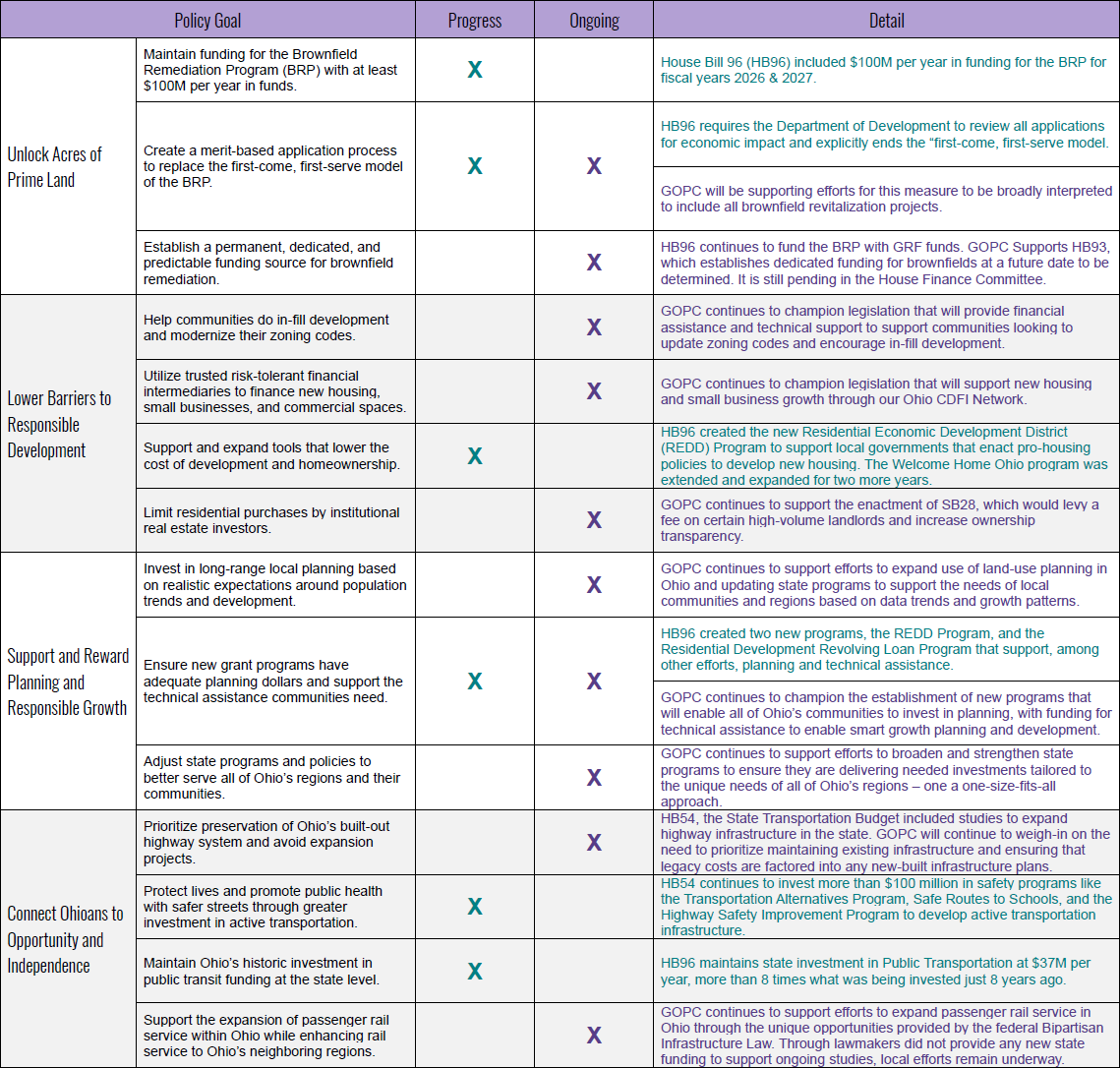Responsible Growth, Sustained Prosperity
Ohio has the 7th largest GDP in the nation, and all communities across the state contribute to this strong position. Although population and industry loss has hit many places, these trends have not stopped Ohioans from working toward new, prosperous, futures.
GOPC’s 2025-2026 public policy agenda, Responsible Growth, Sustained Prosperity, recognizes the path to prosperity can look different for different places. State policies and tools that are sensitive to local context will ensure all communities continue to contribute to Ohio’s standing as an economic leader.
The agenda calls for state policy changes that will give leaders in Ohio’s legacy cities and counties the programs they need to successfully build on assets, protect the strength of existing workforces, and maintain a high quality of life.
GOPC’s agenda also calls for policies that will help the state’s rapidly growing regions seize opportunities and ensure all residents benefit from the regions’ growth.
GOPC’s recommended policies will:
To protect and strengthen the state’s economic competitiveness, Ohio policymakers must move boldly in the next 24 months to create the tools and policy environment Ohio needs to thrive in the next 25 years.
Tracking GOPC’s 2025 - 2026 Policy Accomplishments
Greater Ohio Policy Center's
2025-2026 Public Policy Agenda
Unlock Acres of Prime Land on Brownfields
Ohio has hundreds of sites with utility infrastructure, transportation access, and nearby workers, that are currently unusable due to contaminants from previous uses.
In the last four years, Ohio has invested more than $700 million to assess and clean-up a portion of these brownfields sites in nearly every county of the state. These funds have leveraged millions of additional private and public dollars, transforming blighted properties into new, productive land suitable for redevelopment.
GOPC is proud to have championed this investment, working with policymakers to reactivate land that will house new businesses, homes, and recreation spaces. However, thousands of brownfields still exist across Ohio.
Lower Barriers to Responsible Development
Ohio’s communities do not have a sufficient inventory of quality, attainably-priced homes for homeowners or renters. This is putting immense pressure on the entire housing market.
And many places have underutilized commercial districts that could provide the amenities and services all Ohioans need. In Ohio’s current real estate environment, financing and producing affordably-priced products is difficult. Outdated zoning codes can compound costs.
State investments that help communities update their zoning codes, adopt new housing production tools, control costs, and lower risks will retain current Ohioans and attract prospective employers and residents.
Support and Reward Planning and Responsible Growth
At the end of the day, all development is local. Local government leaders are eager to bring new residential, commercial, and industrial development to their community, but may not always have the expertise or financial resources needed to reach these goals.
Sixty percent of the state’s GDP comes from counties that are expected to experience population contraction. Responsible growth and the state’s partnership with these places will be essential for their long-term prosperity.
Connect Ohioans to Opportunities and Independence
In the next 25 years, Ohio is projected to lose 5.7% of its 2020 population. This means fewer rate payers and smaller motor fuel tax receipts to support our existing transportation systems.
To continue connecting Ohioans to opportunity and independence, Ohio must protect the important transportation assets we already have and prepare for a future where a variety of transportation modes will safely and efficiently connect Ohioans to work, school, medical services, and desired amenities.
Public Engagement
To Plan for Ohio’s Future, GOPC will continue to advocate for policies and initiatives with the Ohio General Assembly and the DeWine Administration related to capital investment, budget and taxation, housing, brownfields, transportation and other areas which work to make Ohio a state where everyone has the opportunity to prosper. GOPC will champion solutions that achieve our vision of a revitalized Ohio.
To see what legislation Greater Ohio Policy Center is following at the Ohio Statehouse, please visit our Bill Tracker.
To learn more about the 2025-2026 Public Policy Agenda or any other issues Greater Ohio Policy Center is following at the Ohio Statehouse, please contact Jason Warner, Director of Strategic Engagement, or Aaron Clapper, Director of Outreach and Projects.







